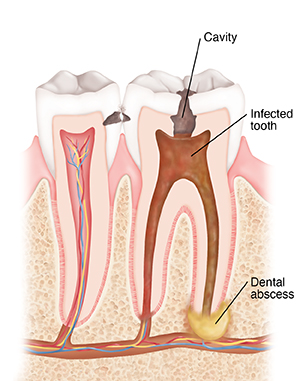You've been diagnosed with a dental abscess. This is a pocket of fluid (pus) at the tip of a tooth root in your jawbone. It's caused by an infection at the root of the tooth. An abscess can occur when bacteria enter the tooth through a crack in the tooth, a cavity, a gum infection, or a combination of these. The pulp inside the tooth gets infected. Then bacteria can spread down the roots to the tip. If the bacteria are not stopped, they can harm the bone and soft tissue. An abscess can form.
Symptoms can include pain, redness, or swelling of the gums, cheek or jaw, sensitivity to hot and cold foods and drinks, bad taste in the mouth, and fever. Pain may spread from the tooth to your ear. Or pain may spread to the part of your jaw on the same side. If the abscess isn’t treated, it looks like a bubble or swelling on the gum near the tooth. The pressure that builds in this swelling causes pain. More serious infections make your face swell.
Home care
Follow these guidelines when caring for yourself at home:
-
Don't have hot and cold foods and drinks. Your tooth may be sensitive to changes in temperature. Don’t chew on the side of the infected tooth.
-
Put a cold pack on your jaw over the sore area to help ease pain.
-
You may use over-the-counter medicine to ease pain, unless another medicine was prescribed. If you have chronic liver or kidney disease, or if you've had a stomach ulcer or gastrointestinal (GI) bleeding, talk with your doctor before using acetaminophen or ibuprofen.
-
An antibiotic will be prescribed. Take it exactly as instructed by your doctor. Take it until it's finished, even if you are feeling better after a few days so the infection completely clears.
Follow-up care
Follow up with your dentist or an oral surgeon, or as advised. Once an infection occurs in a tooth, it will be a problem until the infection is drained. This is done through surgery or a root canal, or you may need to have your tooth pulled.
Call 911
Call
-
Abnormal drowsiness or confusion
-
Headache or stiff neck
-
Weakness or fainting
-
Trouble swallowing, breathing, or opening your mouth
-
Swollen eyelids or vision problems
When to get medical advice
Contact your doctor or get medical care right away if any of these occur:
-
Your face gets more swollen or red
-
Pain gets worse or spreads to your neck
-
Fever of 100.4ºF (38ºC) or higher, or as directed by your doctor
-
Pus drains from the tooth


